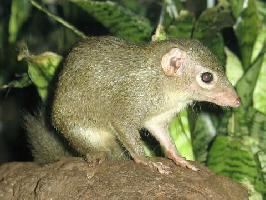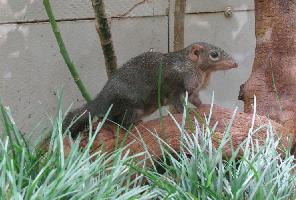
Váhy a míry
| Délka | od 16 do 21 cm |
|---|---|
| Hmotnost | 190 g |
| Délka ocasu | od 12 do 21 cm |
Biologická data
| Počet mláďat | 1 - 3 |
|---|
Popis zvířete
The Common treeshrew, scientifically named Tupaia glis, is a small mammal indigenous to the dense tropical forests of Southeast Asia, including Thailand, Indonesia, and Malaysia. This intriguing creature, despite its name, is not a true shrew and shares a closer evolutionary link with primates, making it an object of interest in scientific studies regarding mammalian evolution.Physically, the Common treeshrew has a slender body that measures about 16 to 21 centimeters in length, with a tail roughly the same length as its body, adding balance and agility to its movements. The animal's coat is predominantly reddish-brown or grayish-brown, providing excellent camouflage against the forest floor and tree bark, which is essential for avoiding predators. Its underbelly is usually lighter, varying from cream to white. The Common treeshrew has a small, pointed face with large, alert eyes and a sensitive nose, which are crucial for detecting predators and foraging for food.
Treeshrews are diurnal creatures, meaning they are active during the day. They exhibit remarkable agility, moving swiftly among the trees and on the ground. Their diet is omnivorous, consisting of fruits, insects, and small vertebrates, which they forage with keen senses. This varied diet is a testament to their adaptability and the role they play in their ecosystem as both predator and prey.
Socially, the Common treeshrew exhibits a unique territorial behavior. Individuals or family units occupy and defend territories, which they mark using scent glands. These territories are crucial for their survival, providing access to food resources and nesting sites. The species communicates through a range of vocalizations, from sharp cries to softer calls, which play a role in social interactions and territorial disputes.
Reproduction in Common treeshrews involves a gestation period of about 45 to 50 days, after which the female gives birth to a small litter of one to three offspring. The young are born in a relatively undeveloped state and require care and feeding from the mother until they are ready to venture out on their own. This period of dependency is crucial for the young treeshrews to learn essential survival skills.
The Common treeshrew's role in the ecosystem is multifaceted; it acts as a seed disperser, aiding in the regeneration of the forest, and as a prey species, supporting predators higher up in the food chain. Despite facing threats from habitat destruction and fragmentation, the Common treeshrew is currently listed as Least Concern by the International Union for Conservation of Nature (IUCN), indicating that it is not currently at risk of extinction. However, the ongoing loss of habitat emphasizes the need for continued conservation efforts to ensure the survival of this and other forest-dwelling species.
In conclusion, the Common treeshrew (Tupaia glis) is a fascinating and adaptable mammal that plays a significant role in its tropical forest habitat. Its unique characteristics and behaviors make it a valuable subject for studies on mammalian evolution and ecology, contributing to our understanding of the complex web of life that sustains our planet's biodiversity.
Podobná zvířata
Nové fotografie zvířat
Top 10 zvířat
- Chinese water dragon (Physignathus cocincinus)
- Galápagos tortoise (Geochelone nigra complex)
- Dolphin gull (Leucophaeus scoresbii)
- Japanese macaque (Macaca fuscata)
- Colombian red howler (Alouatta seniculus)
- Sea urchins (Echinoidea)
- Moustached guenon (Cercopithecus cephus)
- Diana monkey (Cercopithecus diana)
- Common reed warbler (Acrocephalus scirpaceus)
- Common house mosquito (Culex pipiens)
